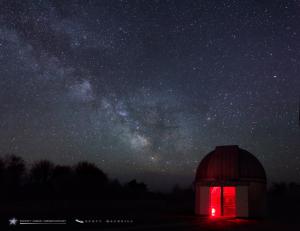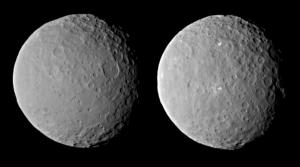
Public Stargazing - CLOSED
- Where:
- Frosty Drew Observatory
- When:
- Friday February 27, 2015 CLOSED
- Cost:
- $1 Suggested Donation per Person
Tonight's weather is calling for partly cloudy skies at sunset becoming clear by 9:00 p.m. The 70% waxing gibbous Moon will be out at sunset and will shine brightly until 2:00 a.m. when it sets. Though tonight could have been an OK night for stargazing if you can withstand the near 0°F temps, Frosty Drew Observatory will be closed. We will return to our regular Friday night Stargazing schedule on Friday March 6th.
Though Frosty Drew Observatory may be closed this week, you can still get your astronomy fix on. A stunningly bright Iridium satellite flare will happen straight over Rhode Island at 7:19 p.m. tonight. Step out a minute or two before and, while facing Southeast look up 45° to catch a bright flare of sunlight reflecting off of Iridium Satellite #31's antenna. Depending on your location, this flare could be excessively bright and quite a spectacle to see. While out grab your binoculars and catch a glance of the gibbous Moon, which will be in a fantastic phase to view the huge Copernicus Crater. Appearing right along the terminator (the point where sunlight ends and the shadow area begins), Copernicus will be in the middle of your view vertically and will appear massive at this angle! A small telescope will only enhance the view.
Astro-withdrawal may happen to those hardcore geeks who hang out with us in the single digit temps, though we will be back in action on March 6th fighting with the near full lunar phase.
-------------------------------------------------------------------------
Weekly Happenings
Scott MacNeill
One week from today, Friday March 6th, will be another amazing day in the history of human space exploration. On this date, the NASA DAWN mission will acquire orbit around dwarf planet Ceres, the largest object in the Asteroid Belt. Ceres has been quite a mysterious object for us. Embedded in the Asteroid Belt, it is the closest dwarf planet to Earth. Recent discoveries have shown water vapor plumes emanating from the surface of Ceres and very recent images take by DAWN during approach show some very mysterious surface features appearing as bright concentrated white regions. During 2011 and 2012 DAWN performed a massive survey of Vesta, the second largest object in the Asteroid Belt and forever changed our view of the little world by sending back over 30,000 images creating an awesome visual map and geological map of Vesta's surface. As DAWN closes in on its final approach the views keep getting better. Follow along with NASA DAWN and join in the adventure as better images keep pouring in.
Please note that the American media is making quite a spectacle about Ceres and Pluto becoming re-classified as terrestrial planets as a result of these missions. The DAWN and New Horizons (Pluto flyby) missions will be mapping surface features and gathering data about surface and atmospheric composition, neither are the basis for planetary classification. As a result these missions are not performing “reclassification science” and any current reclassification claims and desires are solely based on a personal emotional attachment to these worlds (namely only to Pluto, Ceres is the red herring). Emotional attachment to a planetary body, though warm and fuzzy feeling, is not scientific basis for classification. Ceres, residing in the Asteroid Belt, and Pluto, residing in the Kuiper Belt, are both part of a larger group of objects. The DAWN and New Horizons missions will likely not change that fact. Please do not let this lingering minority agenda over shadow the awesome, mind-blowing discoveries coming over the next year as we get our first up-close view of these spectacular worlds and the mysteries that they hold.
-Scott


